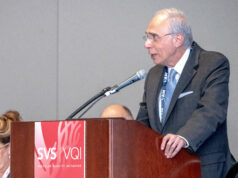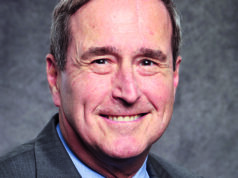
This year’s E. Stanley Crawford Critical Issues Forum zeroed in on the pipeline of sources feeding the vascular surgery ranks. Incoming SVS President Joseph Mills, MD, assembled an expert panel to look at many of the key issues at the heart of efforts to address workforce-related concerns.
The panel captured three main areas of focus: the root sources of future vascular surgeons, the existing workforce, and the distribution of that workforce. Lee Kirksey, MD, from the Cleveland Clinic in Ohio, looked at outreach to high school and college students and Malachi Sheahan III, MD, from Louisiana State University in New Orleans, dealt with efforts to attract medical students and residents in training. Dawn M. Coleman, MD, from Duke University Medical Center in Durham, North Carolina, addressed vascular surgeon wellness, followed by Laura Marie Drudi, MD, from Centre Hospitalier de l’Universite de Montreal in Canada, on burnout solutions. The panel was rounded out by former SVS President Michel S. Makaroun, MD, on workforce supply or maldistribution, and Peter R. Nelson, MD, from the University of Oklahoma in Tulsa, on measures to improve the workforce crisis.
Lee Kirksey on the early years…
“Not everyone is capable of, or wants, to be a physician. I know it’s hard for us in this room to believe that, but not everyone wants to be a physician or vascular surgeon. However, there is a broad range of healthcare ecosystem jobs that provide family-sustaining wages and opportunities for a rewarding career. Much investigation is needed to better understand the student- and family-perceived barriers in pursuing health science careers. We think we know, but when we talk to parents we actually are probably missing the point. And in every community, whether it is urban, indigenous American, rural, White, Black or brown, there are motivated caregivers and communities whom we serve, and they hold surgeons in such high regard, they are waiting for us to take a leadership role in galvanizing the resources and continuing to address the important issue of shaping a multi-dimensional, diverse healthcare workforce.”
Malachi Sheahan III on medical education and training…
“It is time to establish ourselves as the expert on vascular disease at the medical school level. If we don’t, there are other specialties very interested. In a [2016] editorial by the leaders of the American Heart Association and the American College of Cardiology, they say they need an American Board of Internal Medicine-certified specialty focused on patients with peripheral arterial disease [PAD] because their care has been undermined. So if we don’t establish ourselves as the expert, other people will.”
Dawn M. Coleman on surgeon wellness…
“Physician burnout is a public health crisis. Frankly, it is a workforce crisis for us. It is a chronic condition in which your perceived demands outweigh perceived resources. There are staggering personal and professional repercussions of physician burnout. In 2019, burnout was reclassified as an occupational phenomenon by the ICD-11 classification of diseases. And there are also staggering personal and professional ramifications that are associated with work-related stress—which is a precursor for burnout—that have really impressive medical sequelae, including cognitive dysfunction, increased risk of heart disease, type-2 diabetes, fertility challenges, sleep disruptions, insomnia, isolation, etc. Moral distress matters, which can intersect with burnout, and I am positive all of us feel this at some point.”
Laura Marie Drudi on burnout solutions…
“Addressing physician burnout and well-being requires a multi-level, multi-pronged approach that involves both individual and organizational factors. Although burnout is rooted in the environment and systems in which we work, I do believe we have to first turn inwards to fill our own cup before we serve others. For those of you who are experiencing burnout and feel isolated, you’re not alone. Through support, connection and engagement, I am confident we will make progress in this space together.”
Michel S. Makaroun on workforce supply…
“In the last three years, approximately 170 vascular certificates have been issued every year, but we are still far behind the interventional radiologists and interventional cardiologists. So, is the funnel looking a little bit better? It is. We are now producing about 58 new vascular surgeons per year, but it is still inadequate. I will leave with you with this statement from a paper about the county-level maldistribution. ‘Although encouraging vascular surgeons to practice in underserved areas would be an ideal solution, it is not pragmatic.’ Developing alternatives is essential to get new methods of providing vascular care to geographically isolated populations.”
Peter R. Nelson on prophylactic measures to address the workforce crisis…
“We really need to work toward regional systems for efficient education, communication and delivery of multidisciplinary team healthcare. Patients want access to vascular healthcare close to home. They don’t want to come to Tulsa or Oklahoma City to get care. Vascular surgeons can and should lead in these efforts by recruiting vascular surgeons to work in these underserved areas with support from the tertiary referral centers—but, more importantly, to think broadly of how we define workforce, empower other physicians who are already in those communities—primary care providers, podiatrists, general surgeons, cardiologists—to feel more comfortable and confident taking care of vascular disease.”












